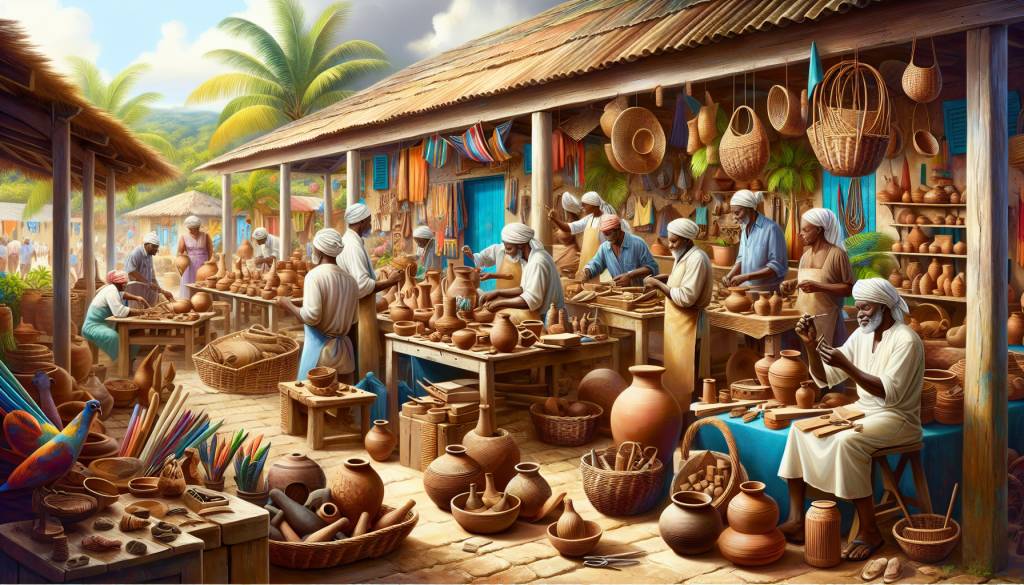Exploring the Rich Tapestry of Martinique’s Craft Heritage
Martinique, a gem in the tapestry of the Caribbean, boasts not only breathtaking landscapes and a vibrant culture but is also a haven for traditional crafts. The island’s local artistry is a reflection of its history and heritage, offering insight into the lives and traditions of its people. Steeped in a rich blend of African, French, and Amerindian influences, the crafts of Martinique tell a story of creativity, resilience, and enduring cultural pride.
The Vibrant World of Martinican Madras
Madras fabric is an emblematic element of Martinican cultural identity. Originally from India, this brightly colored, plaid textile found its way to the Caribbean and became deeply integrated into the local fashion and craft. Madras is most commonly used in the creation of the traditional Creole dress, known as the ‘Wòb Dwiyèt’, which is a key element in Martinique’s folkloric dance and social events. Artisans skillfully incorporate Madras patterns into various accessories and home decorations, showcasing the island’s penchant for color and flair.
Pottery and Ceramics: The Clay Creations of Martinique
The pottery of Martinique has its roots in both pre-Columbian and African techniques. The village of Les Trois-Îlets is particularly well-known for its pottery, where you can find local artisans molding, firing, and decorating their wares in the open air. From utilitarian cookware reminiscent of Amerindian ‘arahus’ to contemporary art pieces, the clays of Martinique tell a tale of art evolving through the ages.
Woodworking and Carving: The Enduring Legacy
Wood carving is another cornerstone of Martinican artisanal tradition. Drawing on the island’s rich forests for materials, craftsmen and women sculpt intricate objects ranging from religious figures to lively carnival masks. Whether it’s the mahogany ‘bwa fouyé’ sculptures which convey the island’s flora and fauna, or the calabash gourds, intricately carved and used as practical vessels or decorative pieces, the woodworking of Martinique stands as a testament to the artisanal dexterity and environmental harmony of its people.
Basketry: A Weave Through Time
Basket weaving is a time-honored tradition in Martinique, with its roots traceable to both African lineage and Arawak ancestry. Using local materials like bamboo, palm leaves, and vetiver, artisans create a variety of woven items. Each piece showcases the versatility and sustainability inherent in the island’s natural resources. Baskets, hats, and other woven crafts are not only useful but also represent the island’s connection to its rural past.
The Delicate Art of Martinique’s Traditional Jewelry
Jewelry making in Martinique is another facet of its artisanal prowess. Using materials like mother-of-pearl, sea urchin spines, and coral, local jewelry makers create stunning pieces that are both modern and steeped in tradition. The iconic ‘chaîne Martinique’, a fine gold necklace symbolic of the island’s culture, remains a sought-after item for both residents and visitors alike.
Textile Arts: Stitching Together Martinique’s Story
Embroidery and textile arts have a special place in Martinique’s craft culture. These techniques, often passed down through generations, result in intricate designs that adorn clothing and household linen. Particularly notable is the ‘pointe de Beauvais’, a specific embroidery technique that displays the dexterity and artistic vision of Martinique’s craftspersons. Through textiles, the island’s narrative is woven in threads of continuity and community.
Culinary Crafts: The Flavor of Martinique’s Artistry
The culinary arts are an often-overlooked aspect of Martinique’s craft tradition. From the distillation of world-renowned rum to the production of sugarcane and cocoa products, food crafts play a significant role in the island’s culture and economy. Gourmet jellies, hot sauces, and savory condiments also highlight the island’s rich agricultural bounty and the creativity of its producers.
Supporting and Preserving Martinique’s Crafts
Supporting the continuation and preservation of Martinique’s traditional crafts is essential. By purchasing authentic Martinican crafts, tourism contributes to the livelihoods of local artisans and ensures that these traditional skills are not lost to time. Workshops, cultural centers, and museums on the island provide a platform for artisans to share their skills with both locals and visitors, fostering a deeper appreciation for the island’s cultural heritage.
Where to Discover Martinique’s Traditional Crafts
Visitors looking to immerse themselves in Martinique’s craft traditions will find a wealth of opportunities. The bustling markets of Fort-de-France offer a kaleidoscope of local crafts, while artisan studios dotted around the island invite a more intimate glimpse into the production process. Festivals and cultural events also provide vibrant showcases of Martinique’s artisanal talents.
Embarking on Your Own Martinican Artisanal Adventure
To truly appreciate the traditional crafts of Martinique, one must not only see but also experience the island’s artisanry. Participating in craft workshops, talking with local artisans, and bringing home a piece of Martinique’s culture are ways that visitors can connect with this magical island. The blend of history, creativity, and passion found in Martinique’s crafts is a journey through local artistry that entices the senses and enriches the soul.




